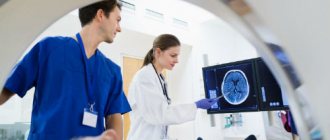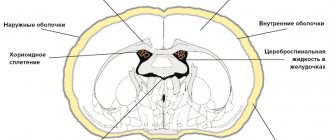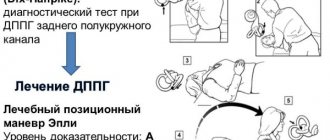Authors: Hérbene Jose Figuinha Milani, Enoch Quindere de Sá Barreto, Renato Luis da Silveira Ximenes, Carlos Alberto Raimundo Baldo, Edward Araujo Júnior, Antonio Fernandes Moron
Features of the development of structures
During pregnancy, the fetal brain, including the structures of the posterior fossa, undergoes more changes than any other organ. Therefore, before proceeding with the assessment of the posterior fossa in the prenatal period, the involved specialists should be familiar with the developmental aspects of these structures (anatomical and embryological) in order to diagnose abnormalities in their formation, in order to avoid confusion between normal aspects of development and possible malformations.
The posterior fossa consists mainly of the following structures:
- cerebellum (including the cerebellar hemispheres and vermis);
- cerebral peduncles;
- fourth ventricle;
- brain stem;
- large tank;
- tent.
Embryologically, the structures of the posterior fossa are derived from the hindbrain (rhombencephalon). The cerebellum, pons, and superior portion of the fourth ventricle arise from the midbrain, whereas the bulb and inferior portion of the fourth ventricle arise from the medulla oblongata.
For ultrasound assessment of the fetal posterior fossa, it is important to remember that Blake's pouch is a normal embryological structure of early fetal development that often disappears around 18 weeks of gestation, with closure of the fourth ventricle (i.e. when there is no longer any connection between the fourth ventricle and the cisterna magna) .
However, the connection between the fourth ventricle and the cistern can still be detected by ultrasound before 20 weeks of gestation.
Ultrasound is the method of choice for screening and diagnosing malformations of the central nervous system of the fetus, including the posterior fossa.
In conventional screening, ultrasound images of posterior fossa malformations are obtained from an axial view of the transcerebellar plane, with the transducer positioned over the pregnant woman's abdomen. In this regard, the following aspects are assessed (Fig. 1):
- cerebellar hemispheres (shape and contours);
- vermis (a more echogenic structure between the two cerebellar hemispheres);
- cerebellum (transcerebellar diameter according to biometrics);
- shape and transverse dimension of a large tank.
However, multiplanar assessment of these structures (including images obtained in the sagittal and coronal planes) is necessary for the differential diagnosis of posterior fossa malformations, which, according to ISUOG guidelines, should be part of the neurosonographic evaluation.
The multiplanar approach is the basis of neurosonographic examination of the fetal brain, which is performed by aligning the transducer with the sutures and fontanelles of the fetal head. Transvaginal transducers have the advantage of operating at a higher frequency than transabdominal transducers and therefore allow better detection of anatomical details.
Figure 1 : Axial ultrasound examination of the transcerebellar plane, evaluation of the cerebellar hemispheres (shape and contours); vermis (a more echogenic structure between the two cerebellar hemispheres); cerebellar biometry (transcerebellar diameter); shape and transverse diameter of a large tank; and the size of the fourth ventricle.
In the coronal projection of the transcerebellar plane (Fig. 2), the following structures are assessed: the cerebellum and the vermis. This plane is very important for differentiation between the cerebellar hemispheres and the vermis, which facilitates the diagnosis of vermis agenesis.
Figure 2 : Coronal ultrasound of the transcerebellar plane assessing the cerebellum; vermis (a more highly echogenic structure located between the two cerebellar hemispheres, yellow arrow). Coronal imaging is very important for differentiation between the cerebellar hemispheres and the vermis.
Undoubtedly, the most important plane for assessing the fetal posterior fossa using ultrasound (mainly for the differential diagnosis of cystic posterior fossa malformations) is the midsagittal plane. In this plane (Fig. 3), the brainstem (pons and bulb, with measurement of the diameter of the pons) can be identified; assess the morphology of the cerebellar vermis using biometry (craniocaudal and anteroposterior diameters); evaluate the fourth ventricle and its fascia; identify the primary groove, which divides the vermis into upper and lower parts, being an important marker of changes in its development (the ratio between the upper and lower parts is usually 1: 2), and they should be determined in 100% of cases.
In cases after 24 weeks of pregnancy, evaluate the cistern magna (shape and diameter); and determine the position of the tentorium, which is an important marker for the differential diagnosis of cystic malformations of the posterior fossa. It is also possible to quantify the upward rotation of the cerebellar vermis and tentorium by measuring two angles: the angle between the pons and the vermis; and between the bridge and the mantle.
3D ultrasound may also be a useful tool in this evaluation because it allows for multiplanar assessment (through the use of 3D applications such as multiplanar, contrast-enhanced volumetric imaging, and OmniView) (Figure 4).
Figure 3 : Ultrasound in the midsagittal plane, the best plane for assessing the fetal posterior fossa (mainly for the differential diagnosis of cystic malformations). The following can be distinguished: brain stem (BS); cerebellar vermis (V), with assessment of its morphology and biometry (craniocaudal and anteroposterior diameter); primary sulcus (yellow arrow); fourth ventricle; tent (white arrow); and tentorium (T).
Figure 4 : 3D ultrasound of the posterior fossa at 28 weeks' gestation, allowing for multiplanar assessment (OmniView). A: Axial image in the transcerebellar plane. B: Reconstruction in the sagittal plane.
Pontocerebellar hypoplasia
Pontocerebellar hypoplasia is a group of rather rare hereditary progressive neurodegenerative diseases. To date, eight types of pontocerebellar hypoplasia have been described. The incidence of the disease is unknown. All forms of the disease share a number of common clinical features, including abnormal brain development, motor problems, developmental delay, intellectual disability, progressive microcephaly, and varying degrees of cerebral manifestations. The disease manifests itself from birth, in some cases the first signs are noted already in utero. Patients usually die in early childhood.
Pontocerebellar hypoplasia type 1 is characterized by pontocerebellar hypoplasia combined with loss of motor neurons in the anterior horn of the spinal cord, making the disease clinically similar to spinal muscular atrophy, particularly spinal muscular atrophy type I. MRI studies reveal cerebellar hypoplasia of varying severity. The pons and other parts of the brain may also be involved. In patients with pontocerebellar hypoplasia, type 1, severe hypotension, paresis, dysphagia, respiratory failure, and delayed psychomotor development are observed. Many patients present with signs of intrauterine onset of the disease, such as congenital contractures and polyhydramnios. Microcephaly is usually absent at birth, but develops later. Patients with pontocerebellar hypoplasia type 1 die in the first year of life.
Pontocerebellar hypoplasia type 2 is the most studied form of the disease. The main signs of pontocerebellar hypoplasia, type 2 include extrapyramidal dyskinesia and dystonia, and in some cases spasticity. Other clinical signs include respiratory failure from birth, the formation of generalized clonus in the neonatal period, and muscle spasms. MRI examination reveals a butterfly-like pattern of the cerebellum with smooth, sharply reduced hemispheres and a relatively small vermis. In 40% of cases, moderate or severe atrophy of the cerebral cortex is observed. Motor neurons of the anterior horns of the spinal cord are not involved in the pathological process. Life expectancy varies from neonatal to adulthood, however, most patients do not survive to puberty.
Pontocerebellar hypoplasia type 3 is known as cerebellar atrophy with progressive microcephaly. Patients are short. The disease is manifested by muscle spasms, hypotension, and symptoms caused by optic nerve atrophy.
Pontocerebellar hypoplasia type 4 or olivopontocerebellar hypoplasia is clinically similar to pontocerebellar hypoplasia type 2 but is more severe. Polyhydramnios, prolonged generalized clonus, congenital contractures, primary hypoventilation of the lungs with the subsequent need for artificial respiratory support are signs of damage already in the prenatal period in such patients. MRI shows clear signs of pathology of brain structures (C-shaped shape of the olivary nuclei of the medulla oblongata, accumulation of cerebrospinal fluid in the pericerebral space, signs of delayed development of the neocortex, etc.), also indicating early, neonatal development of the disease.
Pontocerebellar hypoplasia, type 5 has an intrauterine onset characterized by spasm-like activity in combination with severe olivopontocerebellar hypoplasia and severe damage to the cerebellar vermis.
Patients with pontocerebellar hypoplasia type 6 have cerebellar hypoplasia, encephalopathy, dysphagia, muscle spasms, progressive microcephaly and generalized hypotonia accompanied by spasticity. Biochemical studies revealed a decrease in the activity of mitochondrial complexes I, III, IV in muscles.
Pontocerebellar hypoplasia, type 7 . Signs of the disease are delayed psychomotor development, hypotension, breathing problems, and abnormal development of the genital organs. MRI demonstrates the presence of cerebellar hypoplasia and cerebral atrophy.
Pontocerebellar hypoplasia, type 8 is characterized by severe impairment of psychomotor development, hypotonia, spasticity, and various visual disturbances. An MRI examination reveals cerebellar hypoplasia, thinning of the corpus callosum, and an increase in the amount of white matter.
All eight forms of pontocerebellar hypoplasia are inherited in an autosomal recessive manner. The table presents the currently known genes responsible for the development of pontocerebellar hypoplasia types 1-8.
| Disease | Genes | |
| Pontocerebellar hypoplasia, type 1 | PCH1A (OMIM #607596) VRK1 PCH1B (OMIM #614678) EXOSC3 | |
| Pontocerebellar hypoplasia, type 2 | PCH2A (OMIM #277470) TSEN54 PCH2B (OMIM #612389) TSEN2 PCH2C (OMIM #612390) TSEN34 PCH2D (OMIM #613811) SEPSECS | |
| Pontocerebellar hypoplasia, type 3 | PCH3 (OMIM %608027) locus 7q11-q21, gene unknown | |
| Pontocerebellar hypoplasia, type 4 | PCH4 (OMIM #225753) TSEN54 | |
| Pontocerebellar hypoplasia, type 5 | PCH5 (OMIM 610204) TSEN54 | |
| Pontocerebellar hypoplasia, type 6 | PCH6 (OMIM #611523) RARS2 | |
| Pontocerebellar hypoplasia, type 7 | PCH7 (OMIM %614969), gene unknown | |
| Pontocerebellar hypoplasia, type 8 | PCH8 (OMIM #614961) CHMP1A | |
At the Center for Molecular Genetics, direct automatic sequencing is used to search for mutations in the VRK1 gene.
Pontocerebellar hypoplasia
Cerebellar hypoplasia. Famous video and commentary by a neurologist
At the beginning of May, all websites and forums dedicated to pets and their health were all over this video with the kitten Ralphie and his friend, the dog Max.
Ralphie has cerebellar hypoplasia. We asked several questions about this pathology to the veterinarian of the Biocontrol clinic, surgeon, neurologist Nikolai Aleksandrovich Glazov.
— What is cerebellar hypoplasia? — Cerebellar hypoplasia is a non-contagious, non-progressive neurological condition in animals and humans, in which the cerebellum is smaller than normal or underdeveloped.
- What is the cause of the disease? — The cause of the development of this pathology is most often intrauterine infection of the fetus with the panleukopenia virus (in cats), which the mother is infected with. In more rare cases - as a result of damage by other infectious agents, as a result of birth trauma, poisoning, or intrauterine development abnormalities.
-In which animals does this disease occur? — This disease, in most cases, occurs in cats. It is observed much less frequently in other species, including humans.
— At what age do symptoms of cerebellar hypoplasia appear? — In cats, symptoms of the disease are observed immediately after birth and become more noticeable after the kitten begins to actively move. Cerebellar hypoplasia is rare in dogs; such symptoms become noticeable after 1-2 months.
-What should the owner pay attention to first? — The degree of severity of symptoms will be of greatest importance. If an animal is completely incapable of moving on its own, then it is unlikely to be able to adapt.
— How does this disease manifest itself? — Cerebellar hypoplasia is manifested by gait disturbances, head tremors, and impaired coordination of movements. Animals often fall. Symptoms worsen during excitement.
— How to diagnose the disease? — The final diagnosis is established based on MRI results. But since the clinical symptoms and history are quite specific, most specialists make this diagnosis without additional research.
You should remember the possible causes leading to this pathology. The course of the disease will help the veterinarian establish other differential diagnoses (encephalitis, tumor, etc.).
There is a disease with similar symptoms - cerebellar abiotrophy, which affects many species of animals (usually horses and dogs). With this pathology, Purkinje cells in the cerebellum are gradually lost, and it is genetically determined. Symptoms appear at 2-4 months of life and progress.
— How is this disease treated? “Unfortunately, this pathology is not curable. The animal can only adapt to existence with the symptoms described above.
— Is it inherited? — No, the disease is mainly infectious in nature.
— Does this disease affect the development of other diseases? - No, all the changes have already occurred before the moment of birth. There is no connection with other pathologies.
— How to live with such a cat and how to behave with her? — The owner can help his pet adapt. Non-slip flooring, convenient placement of bowls - all this will greatly simplify the life of a sick animal. There are a lot of portals on the Internet, both Russian-language and foreign, where owners and experts share their observations and findings.
Cerebellar hypoplasia, not in severe cases, is not a death sentence. We must understand that the animal does not feel pain, its mental abilities are not impaired and, having adapted, it lives a fairly full life. It all depends on the wishes of the owner.
ULTRASONIC ASSESSMENT OF THE CEREBELLUM IN THE SECOND TRIMESTER OF PREGNANCY: OPEN CEREBELLA VERSUS
Introduction.
Currently, according to the order of the Ministry of Health of the Russian Federation No. 572n “On approval of the Procedure for the provision of medical care in the field of obstetrics and gynecology (except for the use of assisted reproductive technologies)” dated November 12, 2012, screening ultrasound examination of the fetus in the second trimester of pregnancy in Russia it should be carried out between 18 and 21 weeks of pregnancy. The study of the anatomy of the fetal brain in a screening mode in the second trimester of pregnancy should be carried out using a series of axial sections. One of the slices passes through the posterior cranial fossa and the cerebellum [4]. In this section, it is necessary to carry out a consistent study of the hemispheres and the cerebellar vermis along the entire length, as well as the cerebral cisterna magna [1]. It should be noted that without knowledge of the specific developmental features and ultrasound picture of fetal brain structures depending on the gestational age, in some cases it is almost impossible to make a differential diagnosis between a normal ultrasound picture and pathology of fetal brain development [6]. The cerebellum consists of two symmetrically located hemispheres and the vermis located between them. The cerebellum is one of the most important structures of the posterior cranial fossa. It develops over a long period, begins differentiation as one of the first brain structures, but becomes one of the last to mature [5]. In early pregnancy, the cerebellar vermis does not completely cover the fourth ventricle, which may give the erroneous impression of a cerebellar vermis defect. In later stages of pregnancy, the identification of such an ultrasound picture should raise suspicion of the presence of an abnormal structure of the cerebellum. This picture is normal up to 20 weeks of pregnancy [3]. Ultrasound examination of the fetal brain at the beginning of the second trimester of pregnancy in the axial plane, passing at the level of the cerebellum and cisterna magna, visualizes extensive communication between the fourth ventricle and the cisterna magna. This ultrasound pattern is called a patent cerebellar vermis [2]. Bromley et al first conducted a study in which they assessed the cerebellar vermis from 14 to 16 weeks of pregnancy, after which they published the results of the study and the percentage of fetuses with a patent cerebellar vermis from 14 to 16 weeks of pregnancy. 14 to 16 weeks [3]. In the study, at 14, 15 and 16 weeks, the open cerebellar vermis was visualized in 56%, 23% and 13%, respectively. In this work, the transabdominal ultrasound method was used. Later, data from similar work were published, but using the transvaginal ultrasound method [2]. The results differed significantly from the previous ones, which was explained by the greater resolution when using the transvaginal method: in the period from 14 to 16 weeks of pregnancy, the open cerebellar vermis was visualized in all fetuses, and in the period from 20 to 24 weeks of pregnancy, communication between the fourth ventricle and the cisterna magna was not was found in none of the fetuses.
But we should not forget that wide communication between the fourth ventricle and the cisterna magna of the brain is not always the norm before 20 weeks of pregnancy. Such an ultrasound picture is possible in the presence of developmental anomalies such as Dandy-Walker malformation and cerebellar vermis hypoplasia. Also, an open cerebellar vermis is characteristic of a Blake's pouch cyst [7]. Therefore, in the presence of an open cerebellar vermis, a detailed assessment of them is necessary to exclude anomalies in the development of the structures of the posterior cranial fossa.
Purpose of the study. To estimate the frequency of detection of open cerebellar vermis in fetuses from 16 to 22 weeks of pregnancy.
Materials and methods. To assess the presence or absence of communication between the fourth ventricle and the cistern magna in the fetus, the results of an examination of 177 pregnant women were collected from 16 to 22 weeks. For the final analysis, only data obtained from examining patients whose pregnancy resulted in term labor and the birth of normal healthy children were selected. The age of the examined patients was on average 28 years.
The criteria for selecting patients were:
1) the known date of the last menstruation with a 26–30 day cycle;
2) uncomplicated pregnancy;
3) the presence of a singleton pregnancy without signs of any pathology in the fetus;
4) absence of the fact of taking oral contraceptives within 3 months before the conception cycle;
5) urgent birth of a normal fetus with birth weight within standard values (more than the 10th and less than the 90th percentile for body weight and length, depending on gestational age).
To evaluate the cerebellar vermis, multiplanar reconstruction of the fetal brain was used. Using volumetric echography, an axial section was obtained. The cerebellar vermis was assessed in the axial plane passing through the posterior fossa and the cerebellum. The assessment was carried out retrospectively after collecting volumes of images of the fetal brain on a VolusonE8 (GE) ultrasound machine using special volumetric scanning transducers. At the same time, in the period from 16 to 17 weeks of pregnancy, collection of brain image volumes from fetuses was carried out using a transabdominal sensor in 80.6%, using a transvaginal sensor in 19.4%. In the period from 17 to 22 weeks of pregnancy, in 100% of cases, brain imaging volumes from fetuses were collected using a transabdominal sensor. Analysis of volumetric reconstructions was carried out on a personal computer using a special program 4DView (GE). Statistical analyzes were performed using Excel 2011 spreadsheets.
Research results and discussion. In the course of the study, it was found that at 16-17 weeks of pregnancy the open cerebellar vermis is almost always visualized. This ultrasound picture was detected in 96.8% of fetuses (Figure 1). Only one fetus had a closed worm, which was 3.2%. With increasing gestational age, the percentage of fetuses with an open cerebellar vermis decreased. At 17-18 weeks of pregnancy, an open worm was present in 63.6% of fetuses, at 18-19 weeks in 25% of fetuses, and at 19-20 weeks in 19.5% of fetuses. After 20 weeks of pregnancy, an open cerebellar vermis was not detected in any of the fetuses. In 100% of cases the worm was closed (Figure 2).
The results obtained coincide with the data of foreign researchers [2]. Based on the results obtained, we can talk about the possibility of visualizing the open cerebellar vermis after 18 weeks of pregnancy. This must be taken into account when conducting a second screening ultrasound examination of the fetus.
Conclusions. When conducting an ultrasound examination of the fetal brain in the second trimester of pregnancy, it is necessary to take into account the specific features of the development and ultrasound picture of the structures of the posterior cranial fossa, depending on the gestational age. Visualization of an open cerebellar vermis before 20 weeks of pregnancy is a normal variant. But when this sign is identified, to exclude anomalies in the development of the structures of the posterior cranial fossa, a more detailed assessment of the cerebellum is necessary, including an assessment of the size of the cerebellar vermis. In addition, when conducting a second screening ultrasound examination before 20 weeks and identifying an open cerebellar vermis, it is necessary to conduct a repeat ultrasound examination of the fetal brain after 20 weeks of pregnancy, when the cerebellar vermis should be closed. Compliance with such tactics when conducting an ultrasound examination of the fetal brain in the second trimester of pregnancy will increase the percentage of detection of anomalies in the development of structures of the posterior cranial fossa, as well as reduce the likelihood of false diagnosis of the pathological development of these structures when conducting a second screening ultrasound examination of the fetus up to 20 weeks of pregnancy.
Bibliography
1. Medvedev M.V. Basics of ultrasound screening at 18–21 weeks of pregnancy. 2nd edition, add. iper.M.: RealTime, 2013. 53–54.
2. Ben-Ami M., Perlitz Y., Peleg D. Transvaginal sonographic appearance of the cerebellar vermis at 14-16 weeks' gestation. Ultrasound Obstet.Gynecol. 2002: 19: 208–209.
3. Bromley B., Nadel AS, Pauker S. et al. Closure of the cerebellar vermis: evaluation with second trimester US. Radiology. 1994; 193: 761-763.
4. International Society of Ultrasound in Obstetrics and Gynecology. Sonographic examination of the fetal central nervous system: guidelines for performing the 'basic examination' and the 'fetal neurosonogram'.Ultrasound Obstet.Gynecol. 2007; 29: 109–116.
5. Liu F., Zhang Z., Lin X. et al. Development of the human fetal cerebellum in the second trimester: a post mortem magnetic resonance imaging evaluation. J. Anat. 2011; 219:582-588.
6. Moteagudo A. Fetal neurosonography: should it be routine? Should it be detailed? Ultrasound Obstet.Gynecol. 1998; 12:1–5.
7. Paladini D., Volpe P. Ultrasound of congenital fetal anomalies. Differential diagnosis and prognostic indicators. Second edition. CRC Press is an imprint of Taylor & Francis Group, an Informa business. 2014; 56-62.
If an ultrasound examination reveals markers of fetal chromosomal pathology
- Dear patients, first of all, we ask you to remember the most important thing: if markers (signs) of chromosomal pathology of the fetus were found during an ultrasound examination, this does not mean that the fetus has a chromosomal pathology, and the pregnancy must be terminated.
- All women who have been found to have ultrasound markers of chromosomal pathology of the fetus are offered invasive prenatal diagnostics - today, depending on the stage of pregnancy, we offer three types of invasive diagnostics: chorionic villus aspiration (performed at 11-14 weeks), amniocentesis (16-18 weeks), cordocentesis (19-20 weeks). More information about invasive diagnostic methods can be found at this link.
The most common ultrasound markers of chromosomal abnormalities are:
Increase in TVP.
This parameter is assessed at the first screening ultrasound (11-14 weeks)
TVP (thickness of the collar space) may be greater than normal for several reasons.
Why may the fetus exhibit an increase in TVP?
Parents are extremely excited and want to immediately get answers to all the questions they have - what is involved, what to do, and many others. Questions that cannot be answered immediately. After all, there are many reasons for the increase in TVP. This finding can occur in completely healthy fetuses; this is not a developmental defect, it is only a signal for a more in-depth examination, because such a feature can occur in fetuses with chromosomal abnormalities, heart abnormalities, or other congenital or hereditary diseases. When increasing the maximum TVP threshold, it is IMPORTANT that the doctor evaluates all other ultrasound markers (signs) and also conducts a detailed assessment of the fetal anatomy. Perhaps the reason for the increase in TVP lies in a violation of fetal development (for example, abnormalities in the structure of the heart).
What to do if an increase in TVP is detected in the fetus?
If your fetus is diagnosed with an enlarged TVP, you will definitely be referred for a consultation with a geneticist, who, after collecting an anamnesis, assessing all the risks, will give recommendations on additional research methods (invasive diagnostics). Next, an expert ultrasound of the fetus will be required at 20 weeks for a detailed assessment of the anatomy. If all these studies do not reveal any deviations, then the chances of giving birth to a healthy child are high even with a significant amount of TVP.
Hypoplasia/aplasia of the nasal bones.
Hypoplasia of the nasal bones is a reduction in the size of the nasal bone depending on the CTE of your baby.
Aplasia of the nasal bones is the lack of visualization of your baby's nasal bone.
The lack of visibility of the bony part of the nasal dorsum in the fetus or its underdevelopment (not bright enough) at the first screening is associated with delayed calcium deposition. This situation may be somewhat more common in fetuses with Down syndrome, but it is important that:
- the absence of nasal bones on ultrasound is not a developmental anomaly in itself; can occur in completely healthy fetuses (in 3% of cases);
- to assess the degree of individual risk, it is necessary to evaluate the remaining ultrasound markers (thickness of the fetal nuchal translucency, blood flow indicators on the heart valve, blood flow indicators in the ductus venosus, fetal heart rate) and biochemical analysis of maternal serum (PAPP-A, hCG);
- If the result of a combined screening (evaluation of ultrasound and blood test data in a special program) shows a LOW risk of chromosomal pathology, there is no need to worry. Be sure to undergo a follow-up ultrasound at 19-20 weeks of pregnancy, where a thorough assessment of the fetal anatomy will be carried out and certain ultrasound markers of the second trimester of pregnancy will be examined.
- What to do if the combined screening result is HIGH? – There’s no need to worry. You will definitely be referred for a consultation with a geneticist, who, having collected an anamnesis, assessed all the risks, will give recommendations on additional research methods (invasive diagnostics).
Hyperechoic intestine.
This is a term that refers to increased echogenicity (brightness) of the intestine on an ultrasound image. The finding of hyperechoic bowel NOT a malformation of the bowel, but simply reflects the nature of its ultrasound image. It must be remembered that the echogenicity of the normal intestine is higher than the echogenicity of its neighboring organs (liver, kidneys, lungs), but such intestine is not considered hyperechoic. Only intestines whose echogenicity is comparable to the echogenicity of fetal bones are called hyperechoic.
Why can the fetal intestine be hyperechoic?
Sometimes hyperechoic intestine is detected in completely normal fetuses, and this sign may disappear with dynamic ultrasound. Increased echogenicity of the intestine may be a manifestation of chromosomal diseases of the fetus, in particular Down syndrome. Therefore, when hyperechoic bowel is detected, a careful assessment of fetal anatomy is performed. However, if a hyperechoic intestine is detected, we can only talk about an increased risk of Down syndrome, since such changes can also occur in completely healthy fetuses. Sometimes hyperechoic bowel may be a sign of intrauterine fetal infection. Hyperechoic bowel is often found in fetuses with intrauterine growth restriction. However, this will necessarily reveal a lag in the size of the fetus from the gestational age, oligohydramnios, and impaired blood flow in the vessels of the fetus and uterus. If none of the above is detected, then the diagnosis of fetal growth restriction is excluded.
What to do if hyperechoic intestine is detected in the fetus?
You should contact a genetic specialist who will once again evaluate the results of biochemical screening and give the necessary recommendations for further management of pregnancy.
Hyperechoic focus in the ventricle of the heart.
This is a term that refers to the increased echogenicity (brightness) of a small area of the heart muscle on an ultrasound image. Identification of a hyperechoic focus in the heart NOT a cardiac malformation, but simply reflects the nature of its ultrasound image. A hyperechoic focus occurs at the site of increased deposition of calcium salts on one of the heart muscles, which does not interfere with the normal functioning of the fetal heart and does not require any treatment.
Why can a fetus have a hyperechoic focus in the heart?
Sometimes a hyperechoic focus in the heart is detected in completely normal fetuses, and this sign may disappear with dynamic ultrasound. The presence of a hyperechoic focus in the fetal heart may be a manifestation of fetal chromosomal diseases, in particular Down syndrome. In this regard, when a hyperechoic focus is detected, a careful assessment of the fetal anatomy is carried out. However, this marker refers to the “small” markers of Down syndrome, therefore, identifying only a hyperechoic focus in the heart does not increase the risk of having Down syndrome and is not an indication for other diagnostic procedures.
What to do if a hyperechoic focus is detected in the fetal heart?
If the fetus has ONLY a hyperechoic focus in the heart, then no additional examinations are required; the risk of Down's disease does not increase. At a planned ultrasound at 32-34 weeks, the fetal heart will be examined again. In most cases, the hyperechoic focus in the heart disappears by this stage of pregnancy, but even if it continues to remain in the heart, this does not in any way affect the health of the fetus and the management of pregnancy.
The only artery of the umbilical cord.
A normal umbilical cord consists of three vessels - two arteries and one vein. Sometimes, instead of two arteries, only one artery and one vein are formed in the umbilical cord, thus, only two vessels are identified in the umbilical cord. This condition is considered a malformation of the umbilical cord, but this defect does not have any effect on the postpartum condition of the child and its further development.
Why can a single umbilical cord artery be identified in a fetus?
Sometimes a single umbilical cord artery is identified in completely normal fetuses; After the birth of a child, this fact does not have any impact on its further development. Sometimes a single umbilical cord artery is combined with defects of the fetal cardiovascular system, therefore, when a single umbilical cord artery is identified, a detailed examination of the anatomy of the fetus and, in particular, the cardiovascular system is carried out. In the absence of other malformations, a single umbilical cord artery is able to provide adequate blood flow to the fetus. Somewhat more often, a single umbilical cord artery is detected in fetuses with Down syndrome and other chromosomal diseases. However, this marker is a “minor” marker of Down syndrome, so identifying only a single umbilical cord artery does not increase the risk of Down syndrome and is not an indication for other diagnostic procedures. A single umbilical cord artery sometimes leads to intrauterine growth retardation. In this regard, if a single umbilical cord artery is detected, an additional ultrasound is recommended at 26-28 weeks of pregnancy, and a planned one at 32-34 weeks. If a lag in the size of the fetus from the gestational age or disruption of blood flow in the vessels of the fetus and uterus is not detected, then the diagnosis of fetal growth retardation is excluded.
What to do if a single umbilical cord artery is identified in the fetus?
Identification of only a single umbilical cord artery does not increase the risk of Down syndrome and is not an indication for genetic counseling or other diagnostic procedures. A control ultrasound is required at 26-28 and 32 weeks of pregnancy to assess the rate of fetal growth and evaluate its functional state.
Choroid plexus cysts (CPC).
The choroid plexus is one of the first structures to appear in the fetal brain. It is a complex structure, and the presence of both choroid plexuses confirms that both halves develop in the brain. The choroid plexus produces fluid that nourishes the brain and spinal cord. Sometimes the fluid forms collections inside the choroid plexus, which appear as a “cyst” on ultrasound. Choroid plexus cysts can sometimes be found on ultrasound between 18 and 22 weeks of pregnancy. The presence of cysts does not affect the development and function of the brain. Most cysts disappear spontaneously by 24-28 weeks of pregnancy.
Are choroid plexus cysts common?
In 1-2% of all normal pregnancies, the fetuses have CSS, in 50% of cases bilateral choroid plexus cysts are found, in 90% of cases the cysts spontaneously disappear by the 26th week of pregnancy, the number, size, and shape of cysts can vary, cysts are also found in healthy children and adults. Somewhat more often, choroid plexus cysts are detected in fetuses with chromosomal diseases, in particular with Edwards syndrome (trisomy 18, extra chromosome 18). However, with this disease, the fetus will always have multiple malformations, so identifying only choroid plexus cysts does not increase the risk of having trisomy 18 and is not an indication for other diagnostic procedures. In Down syndrome, choroid plexus cysts are usually not detected. The risk of Edwards syndrome when CSS is detected does not depend on the size of the cysts and their unilateral or bilateral location. Most cysts resolve by 24-28 weeks, so a control ultrasound is performed at 28 weeks. However, if choroid plexus cysts do not disappear by 28-30 weeks, this does not affect the further development of the child.
Enlargement of the renal pelvis (pyelectasia).
The renal pelvis is the cavity where urine from the kidneys collects. From the pelvis, urine moves to the ureters, through which it enters the bladder.
Pyeelectasia is an enlargement of the renal pelvis. Pyeelectasis is 3-5 times more common in boys than in girls. Both unilateral and bilateral pyeloectasia occur. Mild forms of pyelectasis often go away on their own, while severe forms sometimes require surgical treatment.
The cause of dilation of the renal pelvis in the fetus.
If there is an obstacle in the way of the natural outflow of urine, urine will accumulate above this obstacle, which will lead to expansion of the renal pelvis. Pyeelectasis in the fetus is diagnosed by routine ultrasound examination at 18-22 weeks of pregnancy.
Is pyeelectasis dangerous?
Moderate expansion of the renal pelvis, as a rule, does not affect the health of the unborn child. In most cases, during pregnancy, spontaneous disappearance of moderate pyelectasis is observed. Severe pyelectasis (more than 10 mm) indicates a significant difficulty in the outflow of urine from the kidney. Difficulty in the outflow of urine from the kidney may increase, causing compression, atrophy of the kidney tissue and decreased kidney function.
In addition, a violation of the outflow of urine is often accompanied by the addition of pyelonephritis, an inflammation of the kidney that worsens its condition. Slightly more often, dilation of the renal pelvis is detected in fetuses with Down syndrome. However, this marker refers to the “minor” markers of Down syndrome, therefore, detecting only dilation of the renal pelvis does not increase the risk of having Down syndrome and is not an indication for other diagnostic procedures. The only thing you need to do before giving birth is to undergo a control ultrasound at 32 weeks and once again assess the size of the renal pelvis.
Is it necessary to examine the baby after birth?
In many children, moderate pyelectasis disappears spontaneously as a result of the maturation of the urinary system after the birth of the child. For moderate pyelectasis, it may be sufficient to conduct regular ultrasound examinations every three months after the birth of the child. If a urinary infection occurs, antibiotics may be necessary. As the degree of pyelectasis increases, a more detailed urological examination is necessary.
In cases of severe pyelectasis, if the dilation of the pelvis progresses and a decrease in kidney function occurs, surgical treatment is indicated. Surgery can remove the obstruction to the flow of urine. Some surgical interventions can be successfully performed using endoscopic methods - without open surgery, using miniature instruments inserted through the urethra. In any case, the issue of surgical treatment is decided after the birth of the child and its complete examination.
What to do if ultrasound markers of chromosomal pathology are detected in the fetus?
You should contact a genetic specialist who will once again evaluate the results of ultrasound and biochemical screening, calculate the risk individually for your case and give the necessary recommendations for further management of pregnancy.








